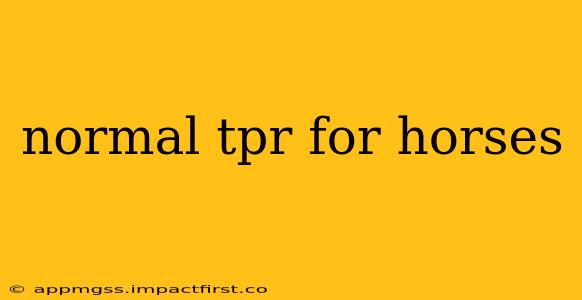Understanding a horse's temperature, pulse, and respiration (TPR) is crucial for any horse owner or caregiver. These vital signs provide valuable insights into the animal's overall health and can be early indicators of illness or injury. This guide will delve into the normal ranges for each, explaining variations and what to look for. We'll also address common questions surrounding equine TPR.
What is a Normal Temperature for a Horse?
A horse's normal temperature typically ranges from 99.0°F to 101.5°F (37.2°C to 38.6°C). Several factors can influence this, including the horse's age, breed, environment, and level of activity. For example, foals often have slightly higher temperatures than adult horses, and strenuous exercise can temporarily elevate the temperature. Always consider the context when assessing a horse's temperature. Using a digital rectal thermometer is the most accurate method for obtaining a horse's temperature.
What is a Normal Pulse Rate for a Horse?
A horse's normal pulse rate falls between 28 and 44 beats per minute (bpm). This is best assessed by palpating the facial artery, located just below the jawbone. Like temperature, the pulse rate can be influenced by factors such as age, fitness level, and environmental conditions. A fit, athletic horse may have a lower resting heart rate than a less active horse. Feel for a strong, regular beat. Irregularities or significant deviations from the normal range warrant veterinary attention.
What is a Normal Respiration Rate for a Horse?
The normal respiration rate for a horse typically lies between 8 and 16 breaths per minute (bpm). Observe the horse's flank movements to accurately count the respirations. A horse's breathing should be smooth and quiet; labored breathing or increased respiratory rate could signify a problem. Remember to count the breaths over a minute for an accurate assessment.
How to Take a Horse's TPR
Accurately measuring a horse's TPR requires patience and a gentle approach. Here's a step-by-step guide:
- Temperature: Use a digital rectal thermometer lubricated with a water-based lubricant. Gently insert the thermometer and follow the manufacturer's instructions.
- Pulse: Gently palpate the facial artery, feeling for the pulse. Count the beats for a full minute.
- Respiration: Observe the horse's flank movements, counting the breaths per minute. Ensure the horse is at rest for accurate readings.
Remember always to prioritize safety when handling horses. If you are uncomfortable taking your horse's TPR, seek assistance from a veterinarian or experienced equine professional.
What if My Horse's TPR is Outside the Normal Range?
Deviations from the normal TPR ranges can indicate various health issues. A high temperature (fever) might suggest infection or inflammation. An elevated pulse or respiration rate could be due to pain, stress, or cardiovascular problems. If you notice any abnormalities, contact your veterinarian immediately. Prompt veterinary attention is crucial for the best possible outcome.
What are the signs of a sick horse?
Signs of illness in horses extend beyond abnormal TPR readings. Look for other symptoms such as lethargy, loss of appetite, coughing, nasal discharge, lameness, changes in stool consistency, and unusual behavior. Early detection and veterinary care significantly improve the chances of successful treatment.
How often should I check my horse's TPR?
Regular TPR monitoring, especially for young horses, older horses, or those with pre-existing conditions, is advisable. While daily checks aren't always necessary for healthy adult horses, monitoring during and after strenuous activity, or when illness is suspected, is recommended.
Can stress affect a horse's TPR?
Absolutely. Stress, whether from environmental factors, handling, or transportation, can cause a temporary increase in a horse's heart rate and respiration. It's crucial to consider the horse's environment and state of mind when assessing TPR.
This comprehensive guide provides a solid understanding of normal TPR ranges for horses and highlights the importance of regular monitoring for maintaining equine health. Remember, early detection is key to successful treatment. If you are concerned about your horse's health, contact your veterinarian without delay.
